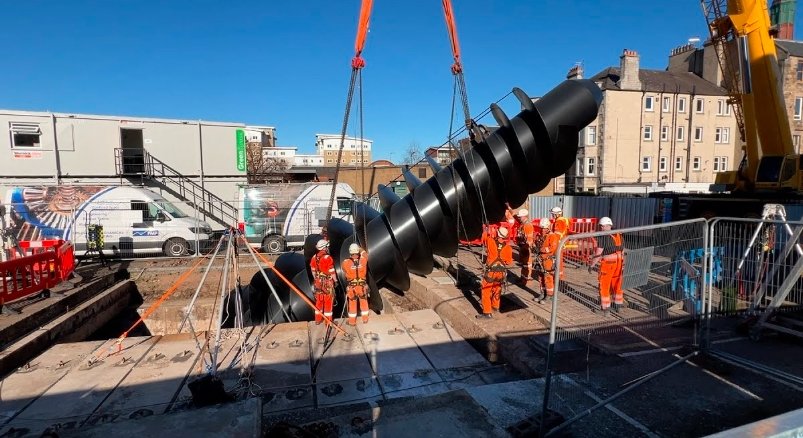Edinburgh’s waste water network just got a major boost. Rare footage reveals a colossal screw pump being lowered into a deep chamber—a feat of engineering that could keep the city’s sewer system humming for decades.
A Hidden Marvel Revealed in the Heart of Edinburgh
Deep beneath the city, a nine-tonne screw pump is making headlines.
The operation, captured on film during a Scottish Water project, shows the giant being carefully lowered into an underground chamber near Broughton Primary School.
Engineers have worked meticulously (oops, I mean with great care) to install this 14.4-metre-long machine as part of a £5 million overhaul at the McDonald Road Waste Water Pumping Station.
The footage is rare, offering the public a glimpse into the world beneath our feet. The pump, known as the “foul” or “duty” screw, is a vital cog in Edinburgh’s waste water network. Its role is to move millions of litres of waste water every second, ensuring that drainage from areas like Canonmills and Broughton flows smoothly into the large sewer system.
The station, operating for over 50 years, is now undergoing major refurbishment to keep pace with modern demands and technological upgrades.
Engineers and local officials alike are buzzing about the project. With infrastructure often out of sight and out of mind, the chance to see such an operation up close is both intriguing and enlightening. It’s not every day that you get a peek at the machinery that keeps a city functioning so smoothly underground.

A Complex Operation with Simple Goals
Scottish Water’s director of capital investment, Rob Mustard, explained the significance of the refurbishment.
“This investment in the pumping station is a major step in supporting service excellence for our customers and the environment,” he stated with evident pride.
His remarks underscore the importance of updating aged infrastructure to ensure reliability and efficiency in waste management.
The operation wasn’t without its challenges. Extracting and installing a component of this magnitude required detailed planning, precision, and a high degree of coordination among multiple teams.
Engineers had to contend with tight spaces, heavy equipment, and the need to maintain uninterrupted service during the installation.
A few key elements made the operation a standout:
-
Precision Handling: The pump had to be moved with extreme caution.
-
Coordinated Team Effort: Multiple teams ensured safety protocols were met.
-
Advanced Planning: Detailed scheduling minimized disruption to the network.
Such projects remind us that behind the everyday conveniences of urban living lies a world of complex, hidden operations that make our lives easier. It’s a testament to modern engineering and the relentless effort of dedicated professionals who work behind the scenes.
Engineering Feats and Community Impact
This latest installation is just one part of a broader effort to modernize Edinburgh’s waste water infrastructure.
The McDonald Road station is undergoing a facelift, ensuring that even after half a century, the city’s sewer network remains robust and reliable.
Engineers are replacing aging machinery with newer, more efficient models to handle the ever-growing demands of urban expansion.
The pump, being lowered with a crane, is a star in this narrative.
Not only does it process up to 1,800 litres of water per second, but it also plays a critical role in preventing blockages and maintaining the overall flow of waste water from key districts.
For the residents of Edinburgh, this is more than just an engineering marvel; it’s a promise of continued reliable service.
A table below summarizes the key aspects of this project:
| Feature | Details | Impact |
|---|---|---|
| Pump Weight | 9 tonnes | Durable and robust performance |
| Pump Length | 14.4 metres | Adequate size to handle large water flows |
| Water Processing Rate | 1,800 litres per second | Ensures efficient drainage |
| Project Investment | £5 million | Major commitment to modern infrastructure |
| Operational Role | Moves waste water from Canonmills and Broughton | Critical for city-wide sewer management |
The installation is being executed in partnership with Morrison Water Services, further emphasizing the collaborative spirit behind major public works.
Project manager William Moore noted, “It’s not every day that people get to see the hidden giants that keep Scotland’s waste and water cycle running.” His enthusiasm underscores the rarity of the event and the pride in showcasing such a vital piece of equipment.
Community engagement plays a role, too. The operation, while technical, has captured the public’s imagination, offering a glimpse into the often-overlooked infrastructure that supports daily urban life.
Residents have the chance to appreciate that beyond the busy streets and modern buildings, there exists a network of underground systems working around the clock.
Future-Proofing the City’s Underground Network
Looking ahead, this project is just one step in a broader initiative to upgrade Edinburgh’s infrastructure.
Modern cities require modern solutions, and the refurbishment of the McDonald Road Pumping Station is a clear signal that Scottish Water is committed to future-proofing the city.
The success of this project could set a precedent for similar upgrades across the region, ensuring that the network remains efficient even as urban demands grow.
The pump installation is complemented by the replacement of a larger “storm screw” which handles waste water during heavy rains.
This storm screw was replaced earlier, in April 2024, after its predecessor was removed in December 2023.
Together, these installations represent a holistic upgrade to a system that has been in operation for decades.
On a personal note, many in the engineering team expressed satisfaction in tackling such a formidable challenge.
The blend of heavy machinery, complex logistics, and the urgency to maintain public service levels makes for a challenging yet rewarding project.
One team member summed it up by saying, “It’s not just about moving equipment; it’s about ensuring our community remains safe and healthy.”
Every piece of equipment installed today is a building block for tomorrow’s infrastructure.
While the work is largely unseen by the average citizen, its impact is felt in every household that benefits from uninterrupted service and a well-maintained urban environment.
There’s a quiet pride in knowing that such giants operate silently beneath the surface, keeping the city alive and kicking.
The project also raises awareness of the need for continual investment in public infrastructure.
Modern challenges, such as increased urbanization and climate change, demand that cities stay ahead of the curve.
Edinburgh’s initiative here is a model for other cities looking to balance tradition with the need for modernization, blending historical operations with the benefits of contemporary engineering techniques.


















